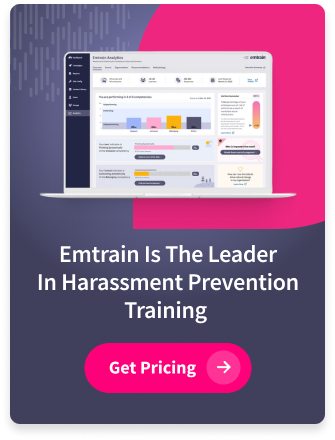Building an effective and impactful program to manage unconscious bias is a journey for practitioners. Likewise, becoming more enlightened around unconscious bias is a journey for each employee. Everyone starts from a different place and moves at their own pace. People can’t be forced to adapt, they need to be encouraged and nudged.
In our work, we’ve observed that subsets of employees approach unconscious bias differently and have very different reactions to top down programs. With noted irony, and at the risk of employing pattern matching, we share those observations here. Our intention is to help other practitioners recognize that a program won’t work equally for all, and that they may need to be patient or provide extra guidance depending on the learner.
Employee approach to unconscious bias |
Managing their unconscious bias journey |
DissentersSome people just don’t believe it. They’re suspicious of social/behavioral science, and they’re confident they properly judge others, end of story. Dissenters often maintain their belief system as a narrative to rationalize their power, privilege, and achievements, and to protect themselves from societal change. |
Dissenters should go through whatever you deem mandatory—like the company-wide unconscious bias training—but you may not get them to do much else. They may also try to work against some of your efforts, so know who they are and how to mitigate their negative influences. Try to have empathy for dissenters. Often, their strong reaction is covering feelings of fear and insecurity. Watch for opportunities to bring them another step along their journey (maybe it’s after a scuffle with another employee, or when you’re bringing on a diverse new hire they’ll need to work with.) Opportunities must be organic and related to their ability to succeed at work. |
SkepticsSome people are open minded, but still grappling with the concept of unconscious bias. They’ve always thought of themselves as good, fair people, yet because of their positive life experiences and privilege, they’re oblivious of the challenges that other people have to navigate. Because of this, they may be skeptical. |
A high quality all-company training will help those early in their journey see some intellectual and emotional avenues to explore. Storytelling will be most impactful for this group, because they’ll see and hear about unconscious bias from people they know, making it more real and personal. You’re helping them take the first few steps. |
Know It AllsSome people think they already know everything they need to know about unconscious bias.They’re more careful in how they treat women, people of color, people of various sexual orientations, etc. They’ve learned how language has changed over the years and adopted the newer terminology. They’re a little smug because they’ve been enlightened, but they don’t have much time for additional learning. They’ve got real work to do. |
Because they understand the basic concept of unconscious bias, this group of employees may be resentful of components of your program that are too basic. Their engagement will come in the more unique areas: an interactive online training where they’re asked about their own opinions and observations, a live training where they can show off their knowledge, a storytelling session where they can feel good being ‘in the room.’ This group is usually only mid-way along the unconscious bias journey. |
Always LearningYour most engaged cohort, these are people who have a growth mindset and are always interested in your unconscious bias program. They’ll read new research, blogs, and training results if they can carve out the time. They’ll come to your voluntary sessions, they’ll lead initiatives, they’ll incorporate each new learning into their own work whether it’s collaborating with others, team management, mentoring, or business strategy sessions. |
The goal of your unconscious bias program is to create as many people in the always learning cohort as possible. Getting more and more people into this enlightened cohort means that learnings from unconscious bias become integrated in everyday behaviors and activities across your organization. This strengthens your company culture and pays dividends with increased productivity and innovation. |
Thought PoliceSometimes you’ll get employees who are over-engaged. They’re so aligned with the unconscious bias and diversity goals that they allocate a lot of their time—probably time they should be spending on their day job—on your initiatives. This could cause problems for their managers (who will react differently, depending on what learner type they are.) It can also cause problems with other employees, if the thought police overstep peer relationships and are too aggressive at getting others to acknowledge their biases and missteps. |
Your thought police will benefit from formalized voluntary roles within the organization where there is structure and feedback. They may be able to lead a project, lead an employee resource group, or serve on an advisory committee. You want and need their engagement, but you need parameters around it too. You want to be able to agree terms of the role and time allocation with their manager. You want a feedback loop where you can help the person grow their awareness of how they’re being perceived by colleagues or how their actions may be detrimental to the longer term initiative goals. And you may want a finite term to their voluntary role (like a six month project, or a one year term as an employee resource group leader) while you help guide their contribution and impact. |
In Emtrain’s Managing Bias course and Diversity and Inclusion course, we recognize and respect every type of employee. We also know that each person comes from a different background with different perspectives. We don’t have quizzes that have ‘right’ and ‘wrong’ answers.
Our approach is to have your employees go through the course experience, and to capture each employee’s opinions and observations as they do. This way, they get information on their own response alongside that of their colleagues (and external learners). And we can provide company leaders (anonymized, aggregated) insights so they can understand the range of their employees’ views.
We want to show where unconscious bias tends to pop up in the workplace (in tasks, meetings, assignments, interviews and promotions) and help employees be more aware and alert the next time it happens. We want to help people understand how to be respectfully curious of others while collaborating with people of different styles and perspectives.
We want to bring the Dissenters down the path of awareness as to why certain behaviors can be so problematic to others, just as we’re providing sophisticated nuanced scenarios that the Thought Police will approve of. It’s not easy work, but by respecting the employee types and letting each of them have their opinion, we can nudge each of them along in their journey.
Contact us if you’d like to see some of Emtrain’s famous video scenes, or how our social polling works within our training suite (Managing Unconscious Bias, Belonging & Inclusion, Preventing Workplace Harassment, Code of Conduct, etc)








